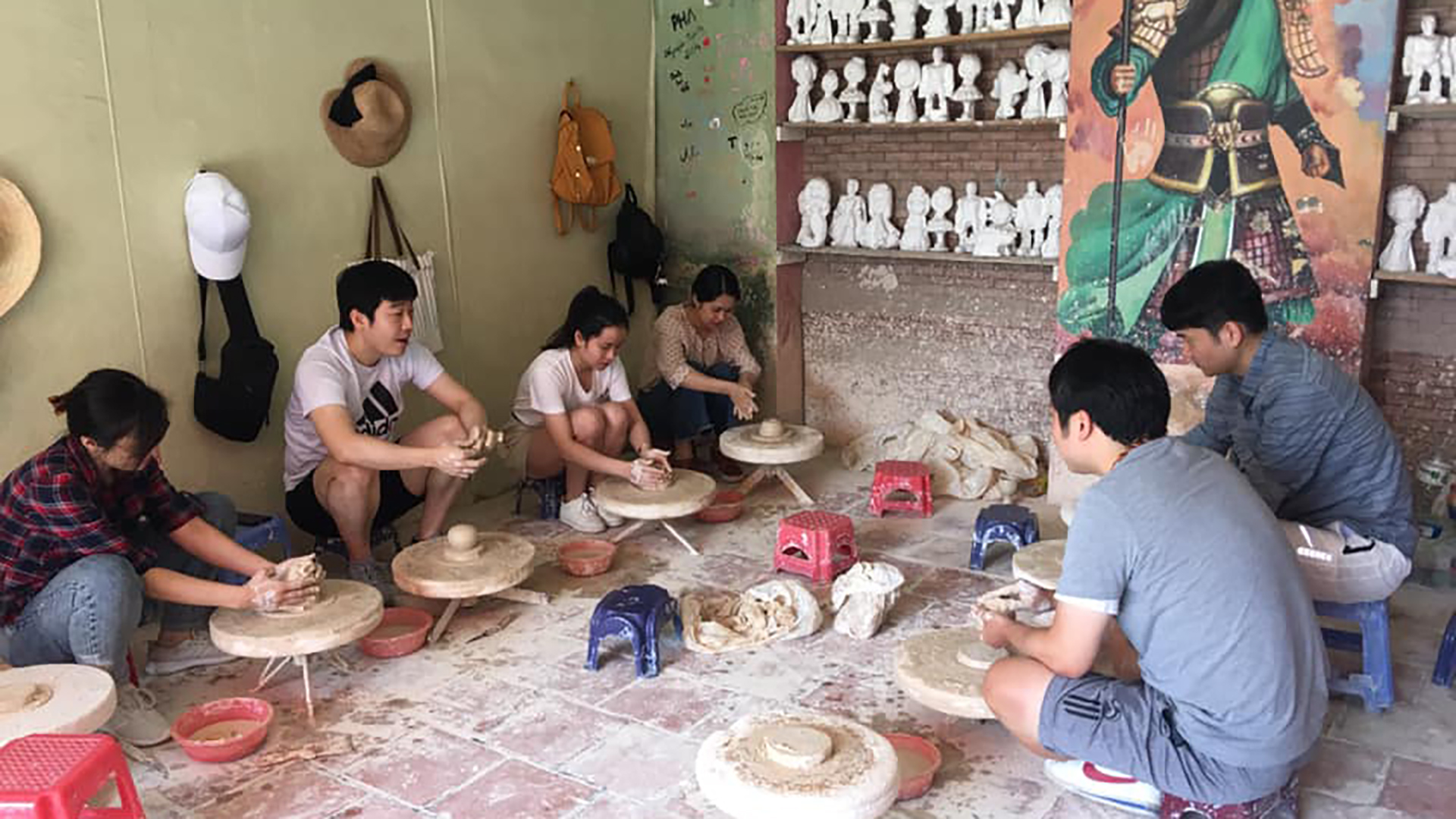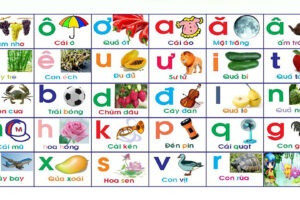
Intergrating culture into the teaching of Vietnamese as a foreign language (Part 2)
5. Linguistic and extra-linguistic outcomes of the culture-related projects
5.1 Cooking project
From the students’ reflections posted on the class blog, it is apparent that the cooking project is great for experiential learning. The benefits of this project can be clearly seen in three aspects. First of all, it gave the students an enjoyable and exciting experience. Following are some quotes from the students’ blogs entries that illustrate this point:
This cooking project is very fun and interesting.
It was fun and lovely Saturday! I do enjoy myself a lot during the entire cooking session.
Like everyone else, I think that the cooking project has been a very fun experience.
I think it’s fun and interesting to have cooking as one of our projects. We had fun and joy throughout the project.
Looking back, this was probably the most enjoyable project we’ve ever had in NUS.
That was the most interesting group project that I ever have in my life of studying.
The cooking session on Saturday was a very enjoyable one. It did not really feel like a project because we had so much fun together.
The students showed that they really enjoyed learning to cook a new dish and getting to know their classmates and teacher better. It is clearly shown in their blog entries that this cooking project was great for interaction and bonding among the students and teachers.
It is the best way for everyone to bond and have fun together. I really enjoyed myself and had a good time interacting with teachers and classmates.
It also gives me a great opportunity to bond myself with each and every of my classmates.
Through this cooking project, I got to know my classmates better. The atmosphere of the cooking project was a lot more relaxed than normal classroom lessons, which is why most of us were more natural and bonded better.
What made the whole project interesting was the bonding between our classmates and teachers.
The food festival was just like a bonding session for everyone where all our teachers became just like friends to us.
Last but not least, the students elaborated on how enriching this cooking project was in helping them to learn more about Vietnamese culture:
It is a good opportunity for us to learn about the Vietnamese culture, their delicacy etc in an interesting way.
This event is enriching and fruitful as we all managed to learn about Vietnamese’s culture during the preparation of food.
It was really a fun experience that helps us to understand an aspect of Vietnamese culture.
Through this project, we experienced just a little more of what life is like in Vietnam, so now we can say that we have spoken the language and tasted the goodness of Vietnamese food!
In class, we can learn to speak the Vietnamese language, but this cooking project allowed us to learn about the Vietnamese culture.
Not only did we get the privilege of tasting the wonderful gourmet of Vietnamese food, we had the privilege of cooking and hence getting a greater appreciation for the Vietnamese culture.
The cooking project allowed us to have a little ‘snippet’ of being Vietnamese. Through this, not only did we learn how to speak Vietnamese, but ‘taste’ it as well! =D
Through this project, the students not only learnt some food-related vocabulary, but they also learnt to cook some well-known Vietnamese dishes such as chả giò, gỏi cuốn, nem gà, gói bánh tôm, chè đậu xanh, chè chuối. They also learnt about the typical ingredients in Vietnamese cooking such as nư c m m and different kinds of herbs, and also about a typical Vietnamese meal. There is one student’s comment that can best summarize the benefits of the cooking project: “As learning a language also includes learning its culture, country and people, this is a precious opportunity for foreign students like us to learn more about Vietnam.”
5.2 Film review project
Two major benefits of the film review project that are evident from the students’ reflective posts are: learning Vietnamese words and phrases in context, and understanding Vietnamese culture and way of life. After watching Bao gi cho ñ n tháng mư i, the students were able to write down 20 new Vietnamese words and expressions with English meaning that they learnt from the film. Their written summary of the film in Vietnamese showed their ability to understand the main content of the film. Their writing about the character in the film that they liked the most showed their capability of describing ideas clearly by using new words and expressions. Their correct spelling of the words and clear understanding of their meanings showed that film was a useful medium for the students to practice listening skills and learn new vocabulary in context. This is also an illustration of learning beyond the classroom.
The students also showed very good critical thinking and reflective skills when writing their reflection on aspects of Vietnamese culture that they learnt from the film, and the similarities and differences between Vietnamese culture and their own culture. Generally speaking, the students’ reflections on culture focused on themes such as way of life, art, belief and religion, filial piety and respect for the elders, rituals, gender differences and patriarchy, family structure, and importance of respect and politeness. For example, on belief and religion, one student wrote:
Another similarity is the prevalence of Buddhist ancestral worship in the Vietnamese household. Some Chinese Buddhists also practice the same custom of having an altar in the house with their ancestor’s tablets or urn and make offerings on special days such as death anniversaries and on also happy occasions such as weddings.
In addition, it is clear from the movie the Vietnamese also share the same belief of the lunar seventh month which is commonly believed to be associated with the release of spirits onto the earth for them to clear up any unsettled affairs or to visit their loved ones.
Filial piety was also observed by many students:
The main similarity of this movie with regards to culture is on the aspect of filial piety. In Singapore, filial piety is a virtue which is widely propagated. Similarly, filial piety can be seen in the movie when Duyen takes care of her father-in-law like her own biological father, keeping the truth of her husband’s death from him in order not to upset him. Another similarity is that both cultures place great emphasis on filial piety, a virtue one must or should possess. This virtue is depicted explicitly in the movie as well.
One student wrote about what he learnt about the structure of a Vietnamese family:
One is that of the structure of a typical Vietnamese family. In marriage, the wife leaves her family and becomes a part of her husband’s as in the film where we see how Duyen is living with the parents of her husband and is such a devoted daughter-in-law.
One student commented on a difference in showing politeness and respect in Vietnamese culture and her own culture:
I learn in the film about the important of respect and politeness in the Vietnamese culture. It is common in the film where the characters all used honorific words such as “d ” in their speech every now and then. The honorific words were used even when talking to people of only slightly older. It is not commonly seen in Singapore where people speak to others who are slightly older, only in moderate politeness.
The students also commented on art:
The form of art between the Vietnamese and Chinese is very similar. The theatre performance shown in the movie is similar to the Chinese theatre performance in the past. However, there is a difference in terms of dressing and make up. Chinese theatre actors have a more elaborated make up and costumes.
Also, we see how Vietnamese culture has been influenced by Southern Chinese culture to some extent in the Vietnamese opera scene where Duyen acts in a play about a husband and wife being separated in war. The performance style is rather similar to the Chinese opera styles we see in Singapore. I find this element in the film – of a play within a play – a very effective means of further exploring the protagonist’s emotions. For the longest time in Singapore, such themes of separation in war and sadness were also explored and portrayed in Chinese opera.
The students’ noticing, comments and analysis of different aspects of Vietnamese culture are a clear evidence of the usefulness of films in introducing the target culture in a vivid and enriching way. This film review project also fostered self-reflection which is very desirable in language learning.
5.3 Blogging project
In another paper (Ho, 2009) I discuss the various benefits of blogging in Vietnamese language teaching and learning, which can be summarized as: blogging to improve reading and writing skills, increased motivation and sense of achievement, blogging to learn more about the target culture, promoting learner autonomy, community of learners, and comments as powerful feedback tools. In this paper, I will focus more on the aspect of promoting understanding of the target culture.
As previously mentioned, the blogging site www.cyworld.vn that was used for this blogging project is entirely in Vietnamese with the majority of its users from Vietnam; therefore, it is an interactive and authentic platform for the students to practice their Vietnamese. The students not only had the opportunity to interact with their classmates and teachers but also some other Cyworld users from Vietnam as well. The students’ interaction with Vietnamese speakers on Cyworld illustrates that this blogging project helped expand the classroom walls and enable the students to reach out to a community of target language users.
In addition, since this blogging site enables its users to upload videos and share videos from other sites, it is a very useful source for information sharing among the students themselves, and between the students and teachers. In fact, many Vietnamese songs and video clips about Vietnamese tourism, films and culture were shared on this blogging site. The students’ sharing of updated articles on current news and events in Vietnam, and their reflection and exchange of opinions on the content of the articles actually helped enhance their understanding of contemporary Vietnam.
Following are some of the reasons why the students thought this blogging project enhanced their understanding of Vietnamese culture and way of life:
I read a lot of articles in Vietnamese and English, and I learnt a lot about Vietnam. I particularly liked this because not being a SE (i.e. South East Asian studies) -major, I was familiar with very little about Vietnam.
I have a better understanding of Vietnam’s social and cultural way of life now.
Lots of updated news, not found in textbook.
I have learnt more Vietnamese terms and was being exposed to many other aspects of Vietnamese which I wasn’t exposed to previously, for example, Vietnamese songs, videos and motivational prose.
6. Implications and concluding remarks
In this paper, I have discussed the implementation and outcomes of three projects for the students enrolled in Vietnamese Language Programme at the National University of Singapore. The three projects are great examples of bringing Vietnamese culture to Vietnamese language classes in a foreign country. The outcomes of the projects can be seen both linguistically and extra-linguistically.
Overall, the three projects are all great success. It is evident from the implementation of the projects that culture learning is beneficial to the students’ language learning. To help enrich the teaching of Vietnamese as a foreign language, I would like to give some suggestions. First of all, it is important to integrate different elements of the target culture that are relevant and useful to the students through such projects. Other options for culture-related projects would be: role-plays, Vietnamese singing and dancing, a travelling project on places of interest in Vietnam, field trip and immersion trip to Vietnam. Secondly, great emphasis should be placed on choosing a right project that is suitable to the proficiency level of students. A project can only be useful when it is within the students’ linguistic capability. For example, a cooking project is suitable for students at beginner’s level, while a blogging project (which requires more advanced language skills) would be too difficult for them. In sum, as language teaching should consist of four elements: language learning, language awareness, cultural awareness and cultural experience (Byram, 1989), I believe that the inclusion of such projects in the Vietnamese as a foreign language education curriculum is beneficial.
Due to time and space constraints, various other aspects of culture teaching in Vietnamese language teaching and learning are not addressed. Further research on how to best integrate culture into language teaching would be desirable.
References
- Brown, H.D. (2000). Principles of language learning and teaching. New York: Longman.
- Byram, M. (1989). Cultural studies in foreign language education. Clevedon, UK: Multilingual Matters.
- Byram, M., Esarte-Sarries, V., & Taylor, S. (1991). Cultural studies and language learning : a research report. Clevedon, Avon, England ; Philadelphia : Multilingual Matters.
- Gumperz, J., & Hymes, D., (Eds.). (1972). Directions in sociolinguistics: The ethnology of communication. New York: Holt, Rinehart and Winston.
- Hinkel, E. (Eds) (1999). Culture in second language teaching and learning. Cambridge: Cambridge University Press.
- Ho, G.A.L. (2009). Blogging and Vietnamese language teaching and learning. Electronic Journal of Foreign Language Teaching, 6 (Suppl. 1), 268-277. Retrieved on December 12, 2010 from http://e-flt.nus.edu.sg/v6sp12009/ho.htm
- Kohonen, V. (2001). Towards experiential foreign language education. In V.Kohenen, R. Jaatinen, P. Kaikkonen, & J. Lehtovaara (Eds.). Experiential learning in foreign language education (pp.8 – 60). Harlow; New York: Longman.
- Kramsch , C. (1991). Culture in language learning: A view from the States. In K. de Bot, R.B. Ginsberg, & C. Kramsch (Eds.), Foreign language research in cross-cultural perspective (pp.217-240). Amsterdam: John Benjamins.
- Kramsch, C. (1993). Context and culture in language teaching. London: Oxford University Press.
Abstract:
Research shows that there is an interrelationship between language and culture. Therefore, it is commonly agreed that knowledge of target culture is beneficial to the acquisition of a target language. For example, Kramsch (1993) states that cultural awareness can facilitate the attaining of second language proficiency. Byram (1989) also shares the view that language teaching can rarely take place without implicitly teaching the culture of its speakers.
Vietnamese is taught as a foreign language in different parts of the world. However, Vietnamese is still an under-researched language, especially when it comes to Vietnamese as a foreign language teaching methodology.
In this presentation, I will share my experiences of integrating the Vietnamese culture to teach Vietnamese as a foreign language to students at a Singaporean university. Three different kinds of projects were used to enhance the students’ Vietnamese cultural awareness. A travelling project, a film review project and a blogging project were conducted to introduce different elements of Vietnamese cultures to students of three different proficiency levels. This presentation will focus on the rationale, procedures, and the benefits of these projects in promoting Vietnamese cultural understanding among the students. Several implications and suggestions will also be put forward to help enrich the teaching of Vietnamese as a foreign language.









